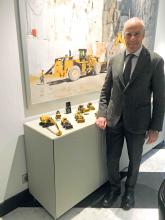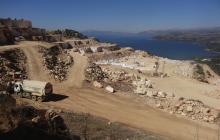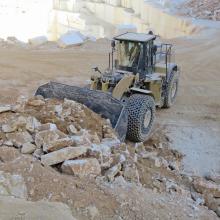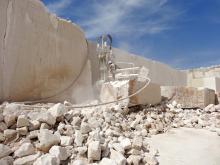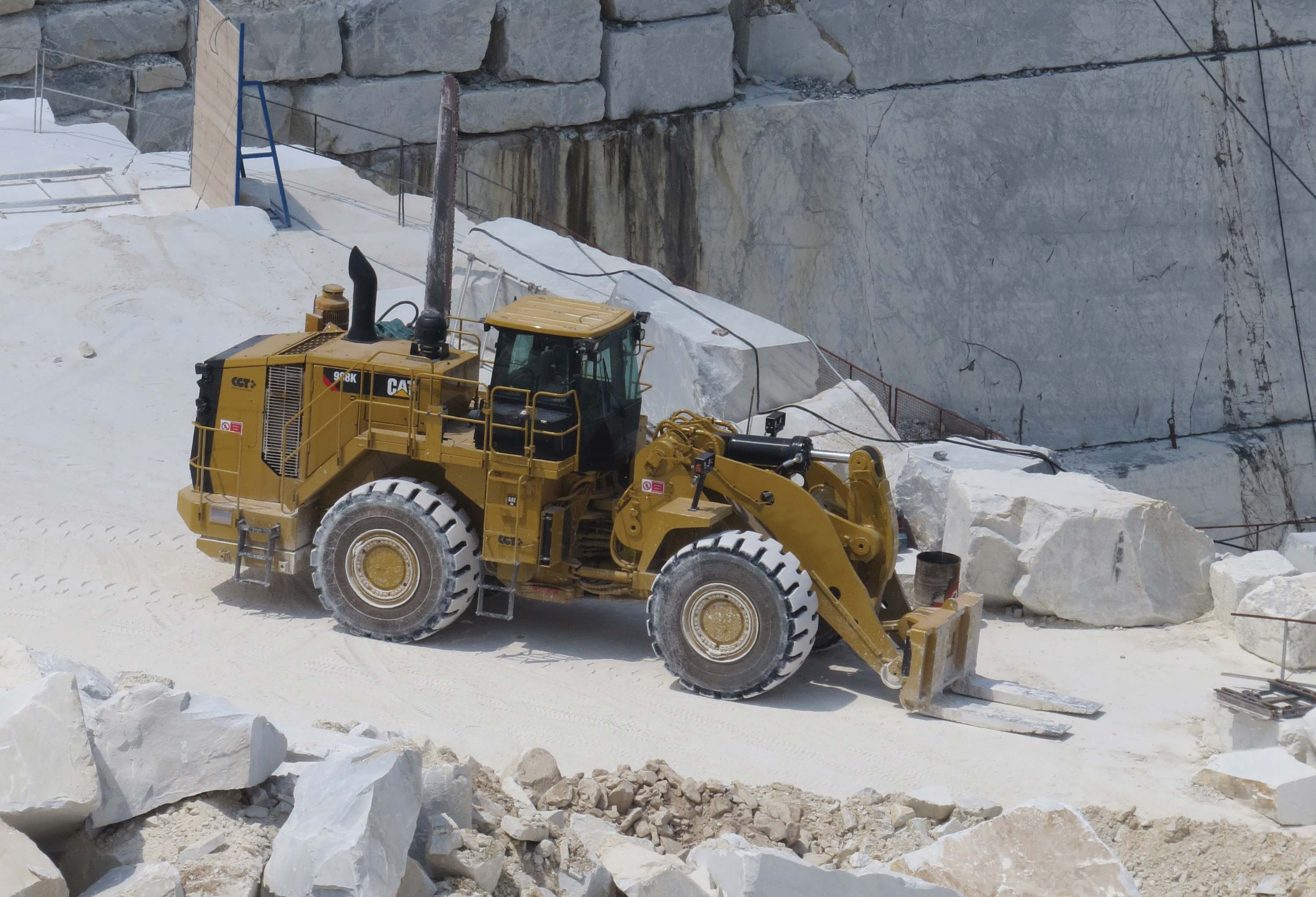
The Italians are world renowned for their sense of fashion, style and quality as typified by sleek cars, smart clothes and food and wine. Such qualities have often been moulded into a brand, and so it is with another highly prized product that can be found 60km north of the city of Pisa, famous for its ancient leaning tower, writes Patrick Smith.
From a distance it looks as though the mountains in the region are covered in snow but as you get closer you can see that the effect is the result of quarrying for the prized marble stone that has for centuries been carved out of the rock. It was used extensively by Michaelangelo, Bernini and Henry Moore, and other renowned sculptors, and on many landmark buildings in Italy and around the world.
This is Carrara in Tuscany where the painstakingly quarried marble can fetch good prices.
We are heading for the Gioia quarry, one of over 200 in the area, and this involves a journey up the side of the mountain, encountering tortuous hairpin bends in a four-wheeled drive vehicle. Here, seat belts are not encouraged.
Below us is another small quarry, which is hosting
Block handling solutions on show include the 988K BH, 988H BH, 980K BH, 980H BH and 966K wheeled loaders; 374F, 349E and 323E excavators; a 730C articulated dump truck (ADT) and the Hydex BH40 block handler from Articulated Truck Solutions. Specifically designed to transport mining blocks around the site easily and safely, the machine is built around the Caterpillar 740B ADT chassis and enables operators to carry single or multiple blocks with a maximum payload of 42tonnes.
The 988H block handler, which weighs 57,000kg, has a lift capacity at ground line of 54tonnes while the 988K block handler weighs 61,500kg and also has a lift capacity at ground line of 54tonnes. The 980K is 34,250kg with a lift capacity at ground line of 26tonnes
Caterpillar says that the 988K is up to 15% more fuel efficient than the 988H it replaces, and is fitted with a Z bar linkage while the 988H has a monoboom linkage, and is said to be ideal for export block handling.
Both are purpose-built for block handling (BH) and have counterweights to provide the stability needed to handle large blocks. In the case of the 988K the optimised counterweight is 8tonnes.
However, there are additional features for both models in BH arrangement. These include high rimpull power train, which features a torque converter and transmission specially designed for this application to maximise rimpull, and an additional hydraulic valve with the Quick Coupler, allowing the operator to switch work tools and immediately lock the work tool during load and carry applications.
Caterpillar says that the 988K BH comes equipped with larger tilt and lift cylinders on the linkage that help improve load control and ensure safe and long-lasting operation, while ride control works by using an accumulator to dampen the linkage motion, acting as a shock absorber, providing the operator with a smoother ride over rough terrain, enabling a more comfortable ride at higher speeds.
So it is not surprising that the quarry at Gioia relies heavily on Caterpillar equipment for its operations, and this includes the manufacturer’s new, recently introduced wheeled loader, the 988K, designed as an optimum loading tool for Cat construction and mining trucks, which is the seventh generation model, marking the 50th anniversary of the 988.
The quarry has another two 988Ks on order, a deal negotiated by CGT, Caterpillar’s Italian dealer, and it is hoped another will be added by the end of the year along with new Caterpillar wheeled loaders and articulated dump trucks.
Meanwhile, along with the 988K, the company relies on a total of five Caterpillar Cat 988H and 988G wheeled loaders, used mainly for block handling, open pit and underground, and four Caterpillar 908H wheeled loaders as support equipment for cleaning the quarry floor and the area in front of the face. Two Caterpillar 740 articulated dump trucks are currently on order.
Marco Franchino of Caterpillar knows the quarry well, and has been busy giving an overview of it to the vehicle-loads of people who have been ferried up and down the mountain during the Caterpillar event.
Experts will tell you that while the equipment for removing the marble has changed over the years, the process of teasing the huge blocks out of the mountainside has not changed that much over the years.
Special sawing equipment cuts into the rock and then a series of holes are drilled vertically and horizontally through the rock after which special diamond tipped wires are passed through these holes to cut in a circular sawing motion front to back.
It can take between two days and a week to cut through the rock and then wedges are inserted to prise it from the face. It is then manoeuvred into position for cutting into manageable blocks, again using high-speed wire saws. Blocks, extracted from the face have a weight of around 200tonnes and are cut into smaller, more manageable blocks with an average weight of 30tonnes. After this the blocks are moved around the quarry using the Caterpillar equipment.
Gioia was founded as the Gioia Quarrymen Cooperative in 1948 by its 90 members and over the years it has also had a certain number of employees (no more than five).
This choice was based on a specific company policy which has always aimed to involve workers profitably in company management, from cultivating the quarry to buying machinery, and from quarry safety to company agreements. In this way members are made responsible and take an active interest in all aspects of company management.
The quarry is in the Gioia basin (Colonnata) and there is one underground operation to extract marble.
Next to the Gioia quarry is another smaller quarry belonging to the Fratelli Antonionelli joint venture, and much of its rock is gained by tunnelling into the face with one of the caverns going back for 500m.
While the home market for marble may be suffering, business is doing very well because of the demand for the product from countries including China, India and the USA.
Marble quarries probably already existed in the Bronze Age when primitive inhabitants of the area used them to produce various utensils and decorative or commemorative objects to bury with their dead.
Real extraction work in Carrara began with the Romans more than 2,000 years ago. Starting from Julius Caesar, quarries began to supply large white marble blocks for the main buildings in Rome and several patrician dwellings. Exports went through the port at Luni.
From the fifth century to the year 1000, extraction stopped following barbarian invasions, and after that, with the spread of Christianity, large quantities of marble were needed for religious buildings and their inside furnishings.
WHEELED LOADERS
3 x Cat 988K
4 x Cat 988H
4 x Cat 908H
3 x Cat 988G
EXCAVATORS
2 x 974
1 x 984 Liebherr
DUMP TRUCKS
2 x Cat 740B
CUTTING
28 x diamond thread machines
4 x chain cutters
This fervid quarry activity is mainly due to the Comacine Masters, including Giovanni Pisano and Nicola Pisano, who used it for their works in central Italy. Then it was the marble used by Michelangelo for his sculptures and he came to choose the blocks he wanted for his works personally.
Marble extraction in the Apuan Alps goes back to the remote past (some 2,100 years ago) and was thoroughly transformed in the 20th century.
In ancient times, diggers used simple methods and tools and it took a long time and a lot of work for really modest results.
The real extraction technique revolution took place at the end of the 19th century with the invention of helical thread and the penetrating pulley. Through these two ingenious techniques the pulley, running along a specific rack enabling it to be lowered continually and regularly, does two things at the same time: as it penetrates the marble it drags along the helical thread cutting the marble block.
The marble railway, the glorious Marmifera, transported the marble for almost a century. Built between 1876 and 1890, it linked the main block storage centres of the three Carrara marble basins, Torano, Miseglia and Colonnata, with the sawing mills down on the plain; the port of Marina di Carrara and the national railway network. It was an incredible feat considering the means available at the time having to overcome a 450m drop for a total of 22km, crossing a great number of bridges and railway lines.
The Marmifera worked for a long time replacing the road network, but competition from modern means of transport made it uneconomic, and after a hard period the railway stopped working in 1964 and its tracks were partly turned into roads.
Today, dozens of trucks trundle down the mountainside every week carrying the precious marble blocks to workshops for processing into finished marble products or for export to customers around the world.
One person at the quarry said: “Carrara marble is among the best in the world. It is a brand, and a very good one, and everyone connected with it is extremely proud of that.”

